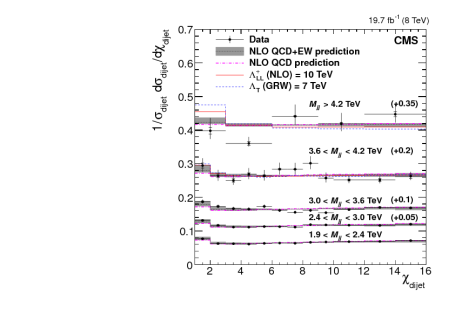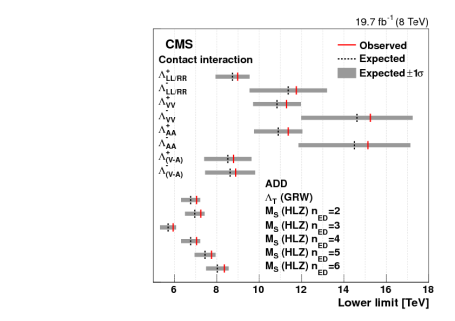Quark contact interactions at the LHC
November 16, 2014 at 10:45 am 1 comment
So far, no convincing sign of new physics has been uncovered by the CMS and ATLAS collaborations. Nonetheless, the scientists continue to look using a wide variety of approaches. For example, a monumental work on the coupling of the Higgs boson to vector particles has been posted by the CMS Collaboration (arXiv:1411.3441). The authors conducted a thorough and very sophisticated statistical analysis of the kinematic distributions of all relevant decay modes, with the conclusion that the data for the Higgs boson are fully consistent with the standard model expectation. The analysis and article are too long for a blog post, however, so please see the paper if you want to learn the details.
The ATLAS Collaboration posted a paper on generic searches for new physics signals based on events with three leptons (e, μ and τ). This paper (arXiv:1411.2921) is longish one describing a broad-based search with several categories of events defined by lepton flavor and charge and other event properties. In all categories the observation confirms the predictions based on standard model processes: the smallest p-value is 0.05.
A completely different search for new physics based on a decades-old concept was posted by CMS (arXiv:1411.2646). We all know that the Fermi theory of weak interactions starts with a so-called contact interaction characterized by an interaction vertex with four legs. The Fermi constant serves to parametrize the interaction, and the participation of a vector boson is immaterial when the energy of the interaction is low compared to the boson mass. This framework is the starting point for other effective theories, and has been employed at hadron colliders when searching for deviations in quark-quark interactions, as might be observable if quarks were composite.
The experimental difficulty in studying high-energy quark-quark scattering is that the energies of the outgoing quarks are not so well measured as one might like. (First, the hadronic jets that materialize in the detector do not precisely reflect the quark energies, and second, jet energies cannot be measured better than a few percent.) It pays, therefore, to avoid using energy as an observable and to get the most out of angular variables, which are well measured. Following analyses done at the Tevatron, the authors use a variable χ = exp(|y1-y2|), which is a simple function of the quark scattering angle in the center-of-mass frame. The distribution of events in χ can be unambiguously predicted in the standard model and in any other hypothetical model, and confronted with the data. So we have a nice case for a goodness-of-fit test and pairwise hypothesis testing.
The traditional parametrization of the interaction Lagrangian is:

where the η parameters have values -1, 0, +1 and specify the chirality of the interaction; the key parameter is the mass scale Λ. An important detail is that this interaction Lagrangian can interfere with the standard model piece, and the interference can be either destructive or constructive, depending on the values of the η parameters.
The analysis proceeds exactly as one would expect: events must have at least two jets, and when there are more than two, the two highest-pT jets are used and the others ignored. Distributions of χ are formed for several ranges of di-jet invariant mass, MJJ, which extends as high as 5.2 TeV. The measured χ distributions are unfolded, i.e., the effects of detector resolution are removed from the distribution on a statistical basis. The main sources of systematic uncertainty come from the jet energy scale and resolution and are based on an extensive parametrization of jet uncertainties.
Since one is looking for deviations with respect to the standard model prediction, it is very important to have an accurate prediction. Higher-order terms must be taken into account; these are available at next-to-leading order (NLO). In fact, even electroweak corrections are important and amount to several percent as a strong function of χ — see the plot on the right.  The scale uncertainties are a few percent (again showing the a very precise SM prediction is non-trivial event for pp→2J) and fortunately the PDF uncertainties are small, at the percent level. Theoretical uncertainties dominate for MJJ near 2 TeV, while statistical uncertainties dominate for MJJ above 4 TeV.
The scale uncertainties are a few percent (again showing the a very precise SM prediction is non-trivial event for pp→2J) and fortunately the PDF uncertainties are small, at the percent level. Theoretical uncertainties dominate for MJJ near 2 TeV, while statistical uncertainties dominate for MJJ above 4 TeV.
The money plot is this one:

Optically speaking, the plot is not exciting: the χ distributions are basically flat and deviations due to a mass scale Λ = 10 TeV would be mild. Such deviations are not observed. Notice, though, that the electroweak corrections do improve the agreement with the data in the lowest χ bins. Loosely speaking, this improvement corresponds to about one standard deviation and therefore would be significant if CMS actually had evidence for new physics in these distributions. As far as limits are concerned, the electroweak corrections are “worth” 0.5 TeV.
The statistical (in)significance of any deviation is quantified by a ratio of log-likelihoods: q = -2ln(LSM+NP/LSM) where SM stands for standard model and NP for new physics (i.e., one of distinct possibilities given in the interaction Lagrangian above). Limits are derived on the mass scale Λ depending on assumed values for the η parameters; they are very nicely summarized in this graph:
The limits for contact interactions are roughly at the 10 TeV scale — well beyond the center-of-mass energy of 8 TeV. I like this way of presenting the limits: you see the expected value (black dashed line) and an envelope of expected statistical fluctuations from this expectation, with the observed value clearly marked as a red line. All limits are slightly more stringent than the expected ones (these are not independent of course).
The authors also considered models of extra spatial dimensions and place limits on the scale of the extra dimensions at the 7 TeV level.
So, absolutely no sign of new physics here. The LHC will turn on in 2015 at a significantly higher center-of-mass energy (13 TeV), and given the ability of this analysis to probe mass scales well above the proton-proton collision energy, a study of the χ distribution will be interesting.
Entry filed under: Particle Physics.
1. buy bitcoin with credit card europe | March 8, 2015 at 3:22 am
buy bitcoin with credit card europe
Quark contact interactions at the LHC | Collider Blog